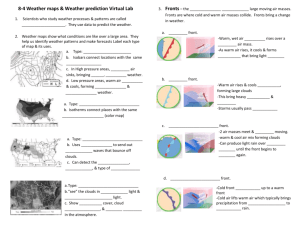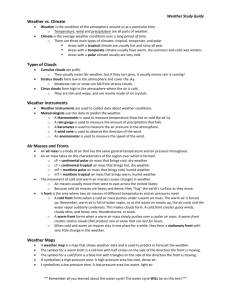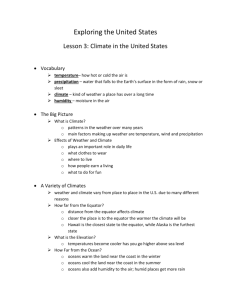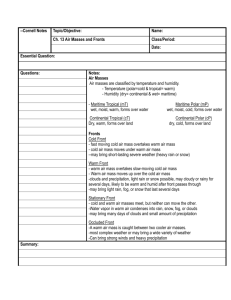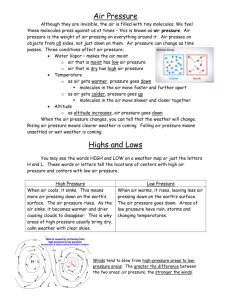Weather and Climate Lesson
advertisement
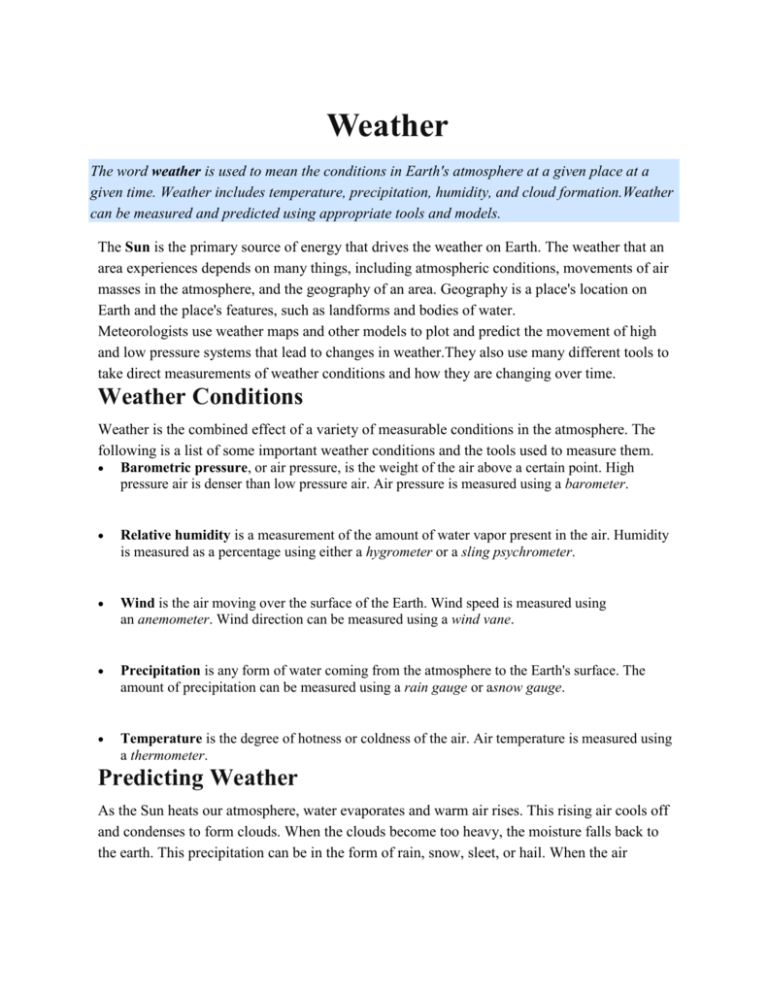
Weather The word weather is used to mean the conditions in Earth's atmosphere at a given place at a given time. Weather includes temperature, precipitation, humidity, and cloud formation.Weather can be measured and predicted using appropriate tools and models. The Sun is the primary source of energy that drives the weather on Earth. The weather that an area experiences depends on many things, including atmospheric conditions, movements of air masses in the atmosphere, and the geography of an area. Geography is a place's location on Earth and the place's features, such as landforms and bodies of water. Meteorologists use weather maps and other models to plot and predict the movement of high and low pressure systems that lead to changes in weather.They also use many different tools to take direct measurements of weather conditions and how they are changing over time. Weather Conditions Weather is the combined effect of a variety of measurable conditions in the atmosphere. The following is a list of some important weather conditions and the tools used to measure them. Barometric pressure, or air pressure, is the weight of the air above a certain point. High pressure air is denser than low pressure air. Air pressure is measured using a barometer. Relative humidity is a measurement of the amount of water vapor present in the air. Humidity is measured as a percentage using either a hygrometer or a sling psychrometer. Wind is the air moving over the surface of the Earth. Wind speed is measured using an anemometer. Wind direction can be measured using a wind vane. Precipitation is any form of water coming from the atmosphere to the Earth's surface. The amount of precipitation can be measured using a rain gauge or asnow gauge. Temperature is the degree of hotness or coldness of the air. Air temperature is measured using a thermometer. Predicting Weather As the Sun heats our atmosphere, water evaporates and warm air rises. This rising air cools off and condenses to form clouds. When the clouds become too heavy, the moisture falls back to the earth. This precipitation can be in the form of rain, snow, sleet, or hail. When the air becomes very humid, and especially if the air cools at the same time, it would be reasonable to predict that it might rain. As the Sun heats the ocean, water evaporates and then forms clouds. An air mass may be warmer or cooler and contain more or less water depending on where the air mass is coming from. Maritime air masses form over water, so they tend to hold more water vapor. Continental air massesare drier because they form over land. Similarly, air masses that are coming from the poles are colder while air masses from the equator are warmer. Hurricanes are most likely to form from maritime air masses that formed near the equator. Since warm air is able to hold more humidity than cool air, these air masses can collect large amounts of moisture as they move north over the ocean. In a hurricane, areas near the center of the storm, except for in the eye, generally receive the heaviest rainfall. The geography of an area can affect what type of air masses move through an area and how they are able to move. Places near large bodies of water tend to have more rain because the clouds produced then release the water as rain.Places near large bodies of water also tend to change temperature less, giving them more moderate weather than similar locations inland. Landforms, such as mountains, are also important to the weather and climate of an area because of the effect that they have on rainfall. For example, when rain clouds blow in from the coast toward mountain ranges, the mountains force the clouds to move upward in the atmosphere. This cools the air so that the water in the air condenses and falls as rain on the near side of the mountains. Because the rain falls before it crosses the mountain, the far side usually receives very little rain. Places that are located on the side of a mountain opposite a large body of water tend to have a very dry climate. Changes in weather often occur at a front. A front is the zone where two air masses meet. A cold front occurs when a mass of cold air pushes under a mass of warm air. This causes moisture in the warm air mass to condense, and usually brings rainfall. Severe weather most often occurs at a front. Weather Maps and Pressure Systems Meteorologists commonly use maps to observe the movement of air masses, which interact with each other and cause changes in weather. Weather tends to move from west to east across the United States, so a weather map can show where severe weather will be hitting next. An example of a weather map is shown below. The light green, spotty areas represent rain. The darker the shade of green, the more intense the rain. Areas of higher and lower pressure cause air masses to move. A high pressure system is a local region of air that is at a higher pressure than air masses around it. It is labeled on a weather map with a capital H. High pressure systems tend to be made up of cooler air. Air tends to diverge, or spread out from high pressure systems. A low pressure system is a local region of air that is at a lower pressure than air masses around it. It is labeled on a weather map with a capital L. Low pressure systems tend to be made up of warmer air. Air tends to converge toward, or move into low pressure systems. Low pressure systems are often at the center of severe weather. Climate Weather and climate are both ways of looking at weather conditions. Weather looks at shortterm conditions and describes conditions in a certain place at a certain time.Climate, on the other hand, looks at long-term weather patterns and describes the weather that is usual for a certain area. Climate The climate of an area is defined based on the weather patterns of the area.For example, saying that today was warm and sunny is describing the weather. Saying that conditions in summer are normally warm and sunny is describing the climate. The climate of a region is influenced by many factors including: the amount of energy received from the Sun - Regions that receive more direct sunlight tend to be warmer. patterns in the movement of air masses (fronts) - Air masses carry moisture and can change the weather conditions. elevation and proximity to mountains - Locations at higher elevations tend to be cooler. Mountains can block rain from reaching some areas. proximity to water and the water cycle - Areas near water tend to receive more precipitation and have more moderate temperatures year round. No two areas are affected by these conditions in the exact same way. This means that no two areas have the exact same climate or weather patterns. Climate Zones Differences in the solar radiation received at different latitudes of the Earth result in different climate zones. This is why similar patterns can be seen in the Northern and Southern Hemispheres as warm air from the equator moves toward the poles. In the Northern Hemisphere, the tropical region begins at the equator and extends to about 23°N latitude. The equator receives a greater input of solar radiation than any other location on Earth. This causes the air at the equator to warm. The warm air rises at the equator and moves toward the North Pole until it reaches the beginning of the temperate region. The temperate region begins at about 23°N latitude and extends to about 67°N latitude. At 23°N, warm air arriving from the equator begins to cool and sink toward the Earth's surface. The sinking air moves along the Earth's surface toward the Equator or toward the northern end of the temperate region (67°N). At the northern end of the temperate region, air warms and rises.Some of this warm air travels south, where it sinks at the southern end of the temperate region. Some of the warm air travels toward the North Pole. The polar region begins at about 67°N latitude and extends to the North Pole.Warm air traveling toward the North Pole gradually cools as it nears the pole, where solar radiation is very limited. The air becomes very cold and sinks toward the Earth's surface. The descending cold air then travels along Earth's surface back toward the south. As it moves toward the south, the air is gradually warmed and rises again at the boundary between the polar and temperate regions (at about 67°N).

